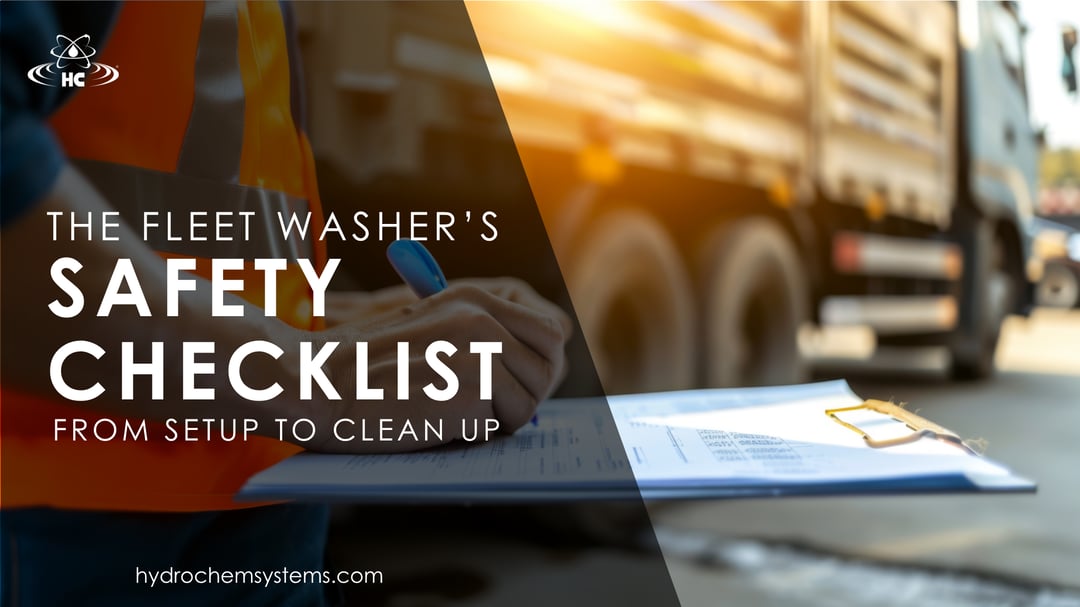Your operation runs smoothly. The crew knows the routine safety basics: use boots and gloves when needed. That's enough, right? Then a mobile washer gets degreaser in their eyes while mixing chemicals. Or your wash bay operator's hands burn hours after refilling chemical tanks without proper gloves.
Now you're dealing with workers' comp claims and investigations. For fleet managers, that means explaining problems to leadership and higher insurance costs. For mobile operators with small crews, losing one person means broken contracts and customers who find someone else.
Most operations don't have a safety problem — until they do. This checklist helps you figure out if your practices actually protect your people and your business — or if you're one incident away from finding out they don't.
Pre-Job Planning & Setup
Before you start washing, take five minutes to set up for a safe workday.
☐ Equipment Inspection
Check your equipment before starting. Look for leaks, damaged hoses, or worn connections. Catch problems before they cause mid-job failures or injuries.
☐ Site Assessment
Walk the area where you'll be working. Look for trip hazards like uneven ground, drain grates, or debris. If you're working near active operations, plan where you'll set up safety cones. Note any areas where you'll need ladders or elevated access.
☐ Safety Supplies On-Site
Make sure you have what you need accessible if something goes wrong:
- Basic first aid kit with bandages, antiseptic wipes, pain relievers, and cold packs
- Eye wash station or bottles
- Calcium gluconate gel if you work with hydrofluoric acid products
- Spill kit for chemical or fuel exposure
- Working phone or radio for emergency communication
Pressure Washing Safety Gear: Your PPE Checklist
The right pressure washing safety gear protects you from high-pressure water and chemicals.
☐ Essential PPE for Every Job
- Eye protection: Safety glasses or goggles to protect against chemical splash and high-pressure water
- Footwear: Slip-resistant, closed-toe boots that are water-resistant, preferably shin-height or taller
- Gloves: Neoprene or nitrile gloves when handling chemicals; insulated gloves for hot water or cold weather
- Weather Protection: Long sleeves or UV-resistant clothing plus sunscreen to protect from chemicals and sun exposure. Stay hydrated with water and electrolytes.
- Hearing protection: Pressure washers are loud—protect your hearing for the long term
☐ Job-Specific PPE
Add these based on your work environment:
- High-visibility clothing when working around moving vehicles or equipment
- Hard hat if working beneath overhead hazards
- Respirator or mask for confined spaces, and when the safety data sheet requires it.
- Fall protection equipment for work on tall ladders, platforms, or roofs
Chemical Handling Safety
Professional cleaning chemicals make your job easier, but you need to handle them safely.
☐ Before Using Chemicals
Check that containers have labels with product names and safety information. Keep Safety Data Sheets on hand. They tell you what PPE you need and what to do if you're exposed. Work in well-ventilated areas and rinse all of the containers you will use.
☐ During Chemical Use
Wear elbow-length nitrile or neoprene gloves when handling concentrated chemicals. Always add chemical to water, never the reverse. Don't mix different chemicals unless the manufacturer directs you to. Rinse containers with water before refilling.
☐ Chemical Storage
Label every container, even temporary ones. Keep chemical names and part numbers matched to the correct Safety Data Sheet. Store chemicals according to the temperature and ventilation requirements listed on their SDS.
Active Washing Safety
Once you start washing, stay alert to the hazards around you.
☐ Prevent Slips, Trips & Falls
Wear slip-resistant footwear and watch your footing on wet, soapy surfaces. Keep hoses organized to avoid tripping. Look where you're moving to spot hazards before you reach them.
☐ Climbing Safety
Maintain three points of contact on ladders. Ensure ladders are stable and at the proper angle. Wet surfaces are slippery—use extra caution. Use fall protection equipment when working above 6 feet.
☐ Active Job site Awareness
Wear high-visibility clothing around moving vehicles and equipment. Use hearing protection, but stay aware of your surroundings. Set up safety cones around wet areas and hoses. Let someone know your location in case of an emergency.
Emergency Response & Cleanup
Even with proper precautions, accidents can happen. Be prepared.
☐ If Chemical Exposure Occurs
Flush your skin or eyes right away with cold water for 15 to 20 minutes. Don't try to neutralize it first. That can make it worse. Use eye wash for eye exposure.
Apply calcium gluconate gel for hydrofluoric acid exposure. Get medical help for serious exposure or if irritation continues.
☐ End-of-Job Checklist
Remove any clothing, footwear, or PPE saturated with chemicals. Inspect your PPE and replace anything that's damaged or no longer effective.
Protect Your Operation
A safety incident affects every operation differently. Fleet managers deal with investigations, increased insurance costs, and operational disruptions. Mobile washing operators face lost contracts and income they can't recover.
This checklist takes minutes to run through, but protects what you've built. Make it part of your routine before every wash job.
The truck washing industry hasn't always emphasized safety labeling and education, but you deserve suppliers who do. If the products you're using don't have clear safety information or accessible Safety Data Sheets, ask your supplier why. You have a right to know what you're handling.
At Hydro-Chem Systems, we've worked with fleets and mobile washers for over 50 years, and we've always prioritized making safety information accessible. Every operation is different, and we can help you customize this checklist. Your safety protocols should reflect your actual setup.
Just download the printable safety checklist to keep on-site. Have questions about chemical safety for your specific operation? Contact our team—we're here to help.



